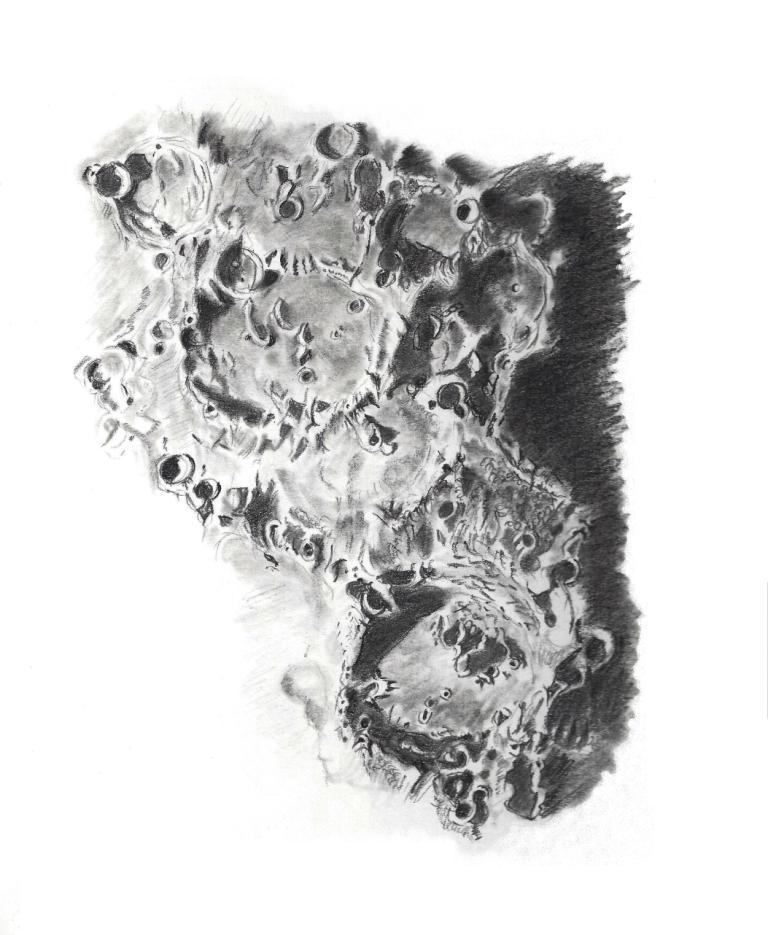
Object name: Thebit, Purbach, Regiomontanus and Walter
Type object: lunar crater
Graphite pencil on white paper
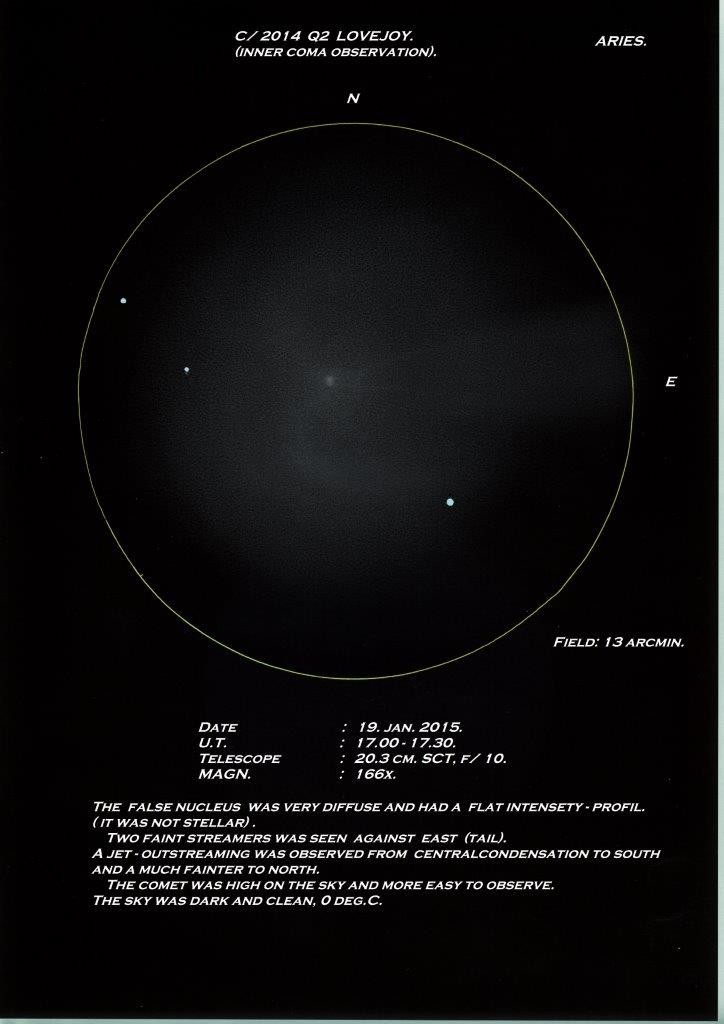
Hey!
This sketch show the inner coma seen in 166x magnification!
The false nucleus was diffus and had a flat intensityprofil (not stellar).
An outstream from nucleus to south was observed and a fainter to north.
Two faint streamers was seen to east (tail).
In 10 x 50 binos., I could see a round and diffuse comet with a very faint,
long tail. The dia. of coma was estimated to 18 arcmin.
The coma was grey, D.C. : 4, Mag.: 4.2.
This time the comet was high on the sky, and easy to observe!
Best wishes from Per-Jonny Bremseth.
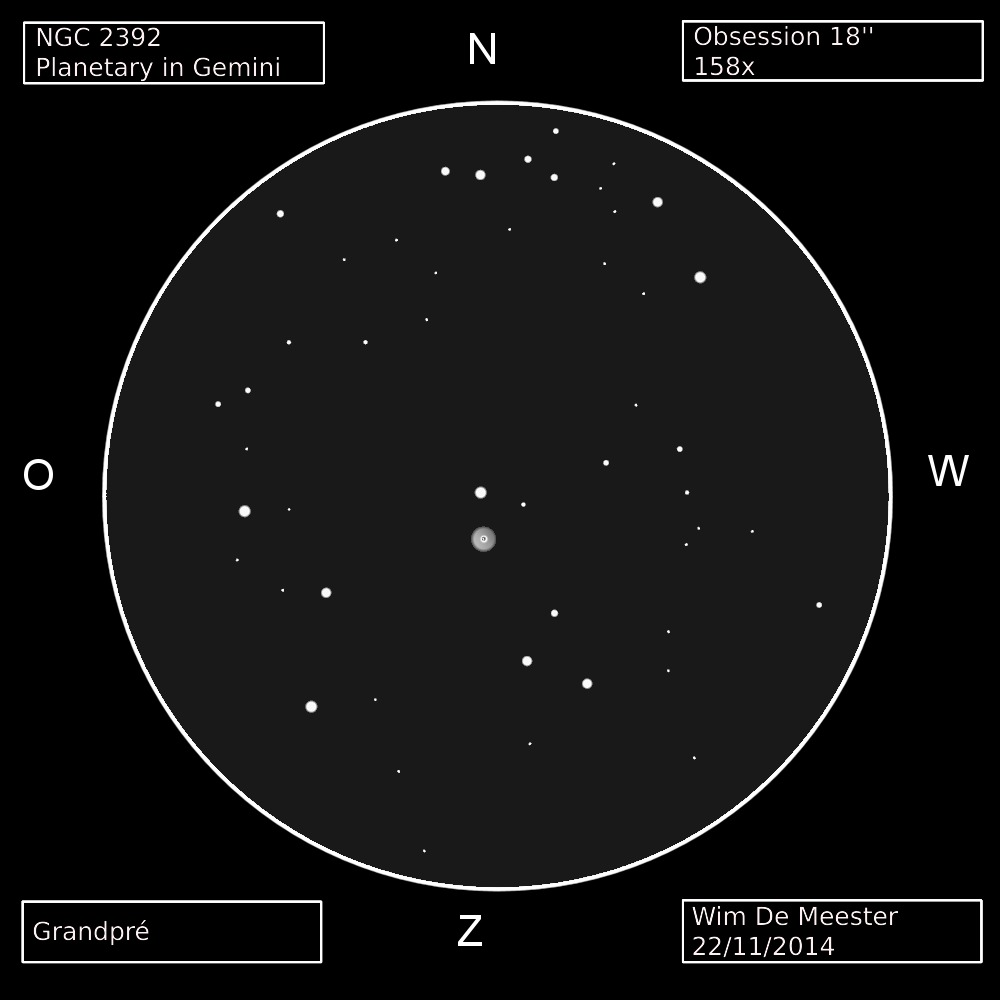
Object Name: NGC 2392, The Eskimo Nebula
Object Type: Planetary Nebula
Location: Grandpré, France
Date: November 22, 2014
Media: Digital drawing, using krita (https://krita.org)
More information on
http://deepskywim.blogspot.be/2015/01/drawing-of-eskimo-nebula.html
It was a very humid night. Observation made with my 18” Obsession.
Cheers,
Wim
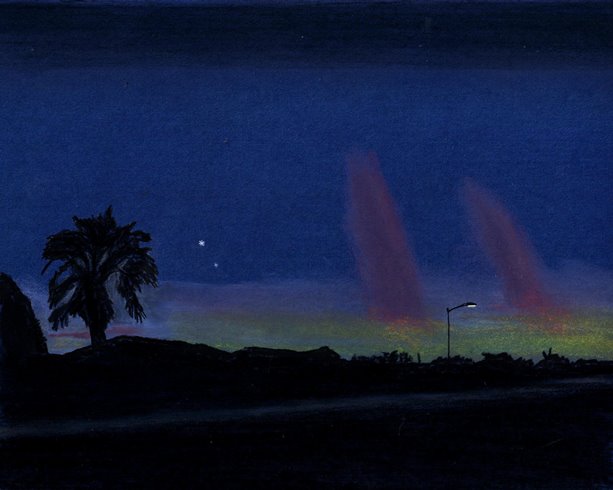
Venus and Mercury were putting on a great show over several days at my location.
You didn’t need optical aid to enjoy the view of the sky to the southwest. Distant tropospheric clouds are likely responsible for the separate pink/violet pillars clearly visible after sunset for a brief time.
Venus was visible before sunset but Mercury required a darker sky to shine through for naked eye visibility.
Sketching:
Location: Mesa, Arizona
Date and Time: January 6, 2015, 18:15 pm local time
Temperature: 19° C (67° F)
Venus visual magnitude -3.9; distance from Earth 1.6 au
Mercury visual magnitude -0.8; distance from Earth 1.2 au
Assorted color pencils and pastel crayons, blue construction paper cut to size to fit my clipboard,
blending stumps and facial tissue paper for blending, white Pearl eraser.
Frank McCabe
Hello all,
One thing all astronomers chase is ideal atmospheric conditions. An apparently clear night can present poor transparency or poor seeing due to thermal energy high up in the atmosphere. But every now and then, ideal or even very close to ideal conditions do present themselves, and it gives us the finest view of the heavens.
Such conditions presented themselves to me on the night of January 18.
My first view of Thor’s Helmet, NGC 2359, was four years ago during the Ice In Space Astro Camp. My view of it seemed to me to be a fine one. So much so it inspired me to sketch it straight away! Four years later, presented with a night of exceptional transparency, I revisited Thor’s Helmet as it was right on zenith for me.
WOW! What an image! This night Thor’s Helmet had nebulosity extending in four different directions, not just the two from my first view. So much more structure was apparent, and the nebulosity extended so much further, and so many more stars were visible too.
I’ve also included an image of the sketch I did of Thor’s Helmet in 2011 for comparison. It is this way that the full impact of the differences in conditions between the two nights can be appreciated.
I hope you enjoy this sketch.
Alex.
Object: Thor’s Helmet, NGC 2359
Scope: 17.5” push-pull Karee dob
Gear: 30mm 82° Explore Scientific, 91X, OIII filter
Date: 18th January, 2015
Location: Katoomba Airfield, Australia
Media: White soft pastel, charcoal and white ink on A4 size black paper
Duration: approx. 1hr.
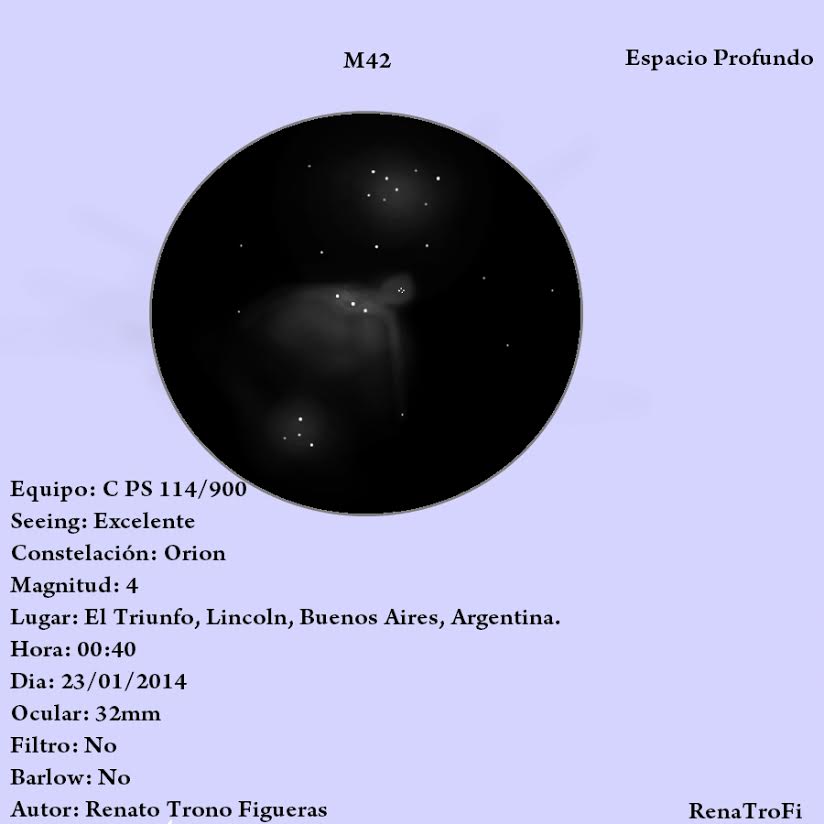
Hi, ASOD. My name is Renato Trono Figueras from Lincoln, Buenos Aires, Argentina. I’m 15 years old.
Objet Name: NGC 1976/ Messier 42/ Orion Nebula
Objet type: Diffuse Nebula
Location: A country village called “El Triunfo” (Argentina).
Date: 23/01/2014
Media: Digital Tools (Photoshop)
Seeing: Excellent
Transparence: Excellent
Weather: Clear
Telescope: Newtonian Reflector 4.5″ (114mm/ 900mm)
I hope that you post my skecth. Thanks you very much!
Sorry if my english is not good
Regards and Good Luck!!
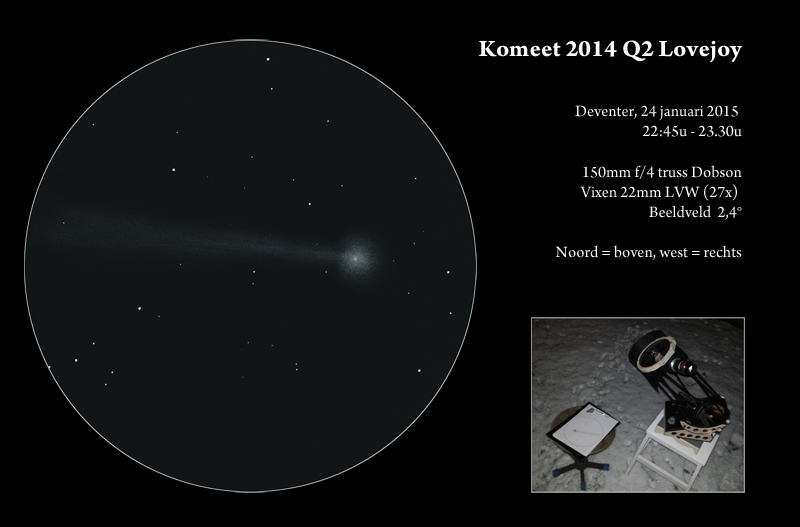
Object Name: 2014 Q2 (Lovejoy)
Object Type: Comet
Location: Deventer, The Netherlands
Date: Januari 24, 2015
Media: Graphite pencil on white paper
Could it be any better? A nearly finished newly built telescope, clear skies after a full week of clouds, a bright comet visible from my backyard practically made for a scope this size…
I made a sketch of comet Lovejoy through my 150mm f/4 Dobsonian. At first sight I couldn’t spot the tail, but as my eyes became more and more dark adapted, a faint tail began to grow larger and larger. It remained faint but the shape was well visible: quite narrow, slightly brighter near the coma, and gradually widening towards the east. Unfortunately I did not detect the greenish color some reported. In the sketch north is up, east is left.
Clear Skies!
Roel Weijenberg
www.roelblog.nl
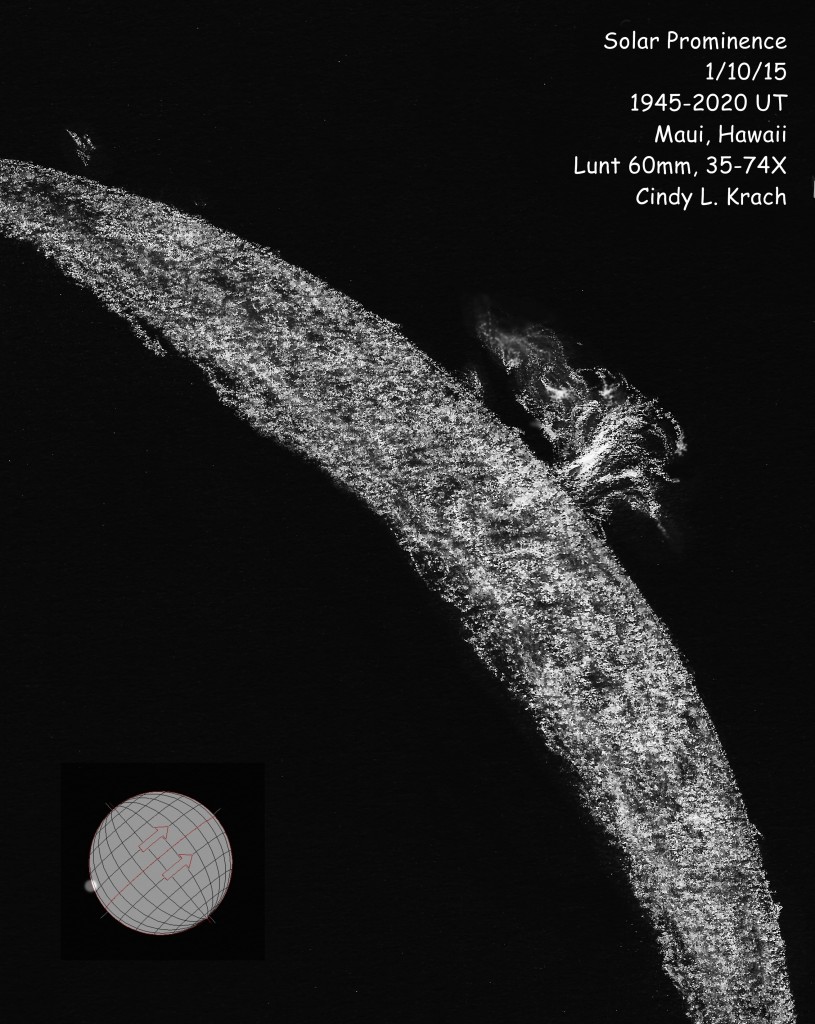
Aloha!
I think what I like best about solar observing is you never know what you will find going on! This large prominence at the eastern limb appeared extraordinary in its detailed and lacey appearance. Seeing was very good and at higher magnification a network of bright areas appeared, much like a picture of a neuron cell with branching filaments extending in all directions. Tilting Sun Graphics are used to denote prominence location.
Solar Prominence
1/10/15
h-alpha 60mm Lunt
Maui, Hawaii
0945-1020 HST (1945-2020 UT)
Black Canson paper, white & black charcoal pencil, watercolor pencil & Conte’ Crayon
Tilting Sun Graphics
Cindy (Thia ) L. Krach
Haleakala Amateur Astronomers
Webmaster’s note: ASOD is experiencing problems with sketch submissions where the file size exceeds the limit of the ASOD WordPress programs capability to process the file. Please be aware that when this occurs, although we do have some graphic editing programs, large files will result in two or three iterations of resizing, that may still result in a sketch that cannot be downloaded to the ASOD template. Due to the fact that I have a day job, I often put these pages together late at night, and being very tired I have difficulty trying to bring these posts together. Please be aware that we would prefer receiving files that are no bigger than 800 pixels wide. We will always resize your sketch image to 650 pixels to fit on all the the standard protocols for tablets and smart phones. Please make sure the image file size (the number of bytes the image file) contains does not exceed 500 Kilobytes. This will guarantee that your sketch is published in it’s entirety, and on time. If there are any questions, please feel free to contact us here at ASOD, we will be happy to help with any problems that are troubling you with image size issues.
Keep up the great work,
Jeremy Perez
Rich Handy
ASOD webmasters
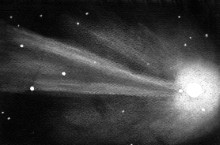
My latest sketch for your interest. As previous, 153mm OG Watec 120N+ video camera, sketched from b&w monitor onto black art paper with white Conte hard pastel, watercolour pencil and white acrylic paint.
Regards, Dale
Do you want to know more about my interest in astronomy? If so take a look at my Website: www.chippingdaleobservatory.com
Keep up to date with observations from Chippingdale Observatory by reading the Blog http://chippingdaleobservatory.com/blog/